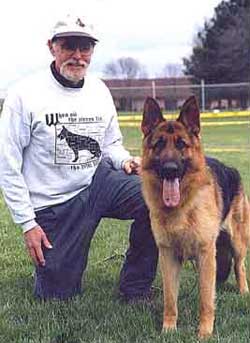David Landau
Teaching and research are often portrayed as residing at opposite ends of the learning spectrum, but to David Landau, a 30-year long physics professor at the University of Georgia, the two are closely interrelated.
This belief as served as Landau's guiding principle not just in his academic career, but in his other, nearly 30-year long endeavor as a serious trainer and breeder of German Shepherd dogs.

Dr. Landau with one of his dogs.
“When you are doing research, your mind is constantly involved in an investigative and creative mode. This constant search and constant inquisitiveness helps you question the ways of doing things in general. I have been able to introduce new materials into my courses [and not] teaching the same way year after year,” Landau says.
As a physics professor, he has taught well over a thousand students in his 30-year long career and served as research advisor to 25 Ph.D. students. He has utilized the development of computer simulations to conduct research and to improve his teaching, and he now serves as Director of the Center for Simulational Physics at the University of Georgia.
As a breeder and trainer of German Shepherds, Landau and his wife have bred and raised about 600 such dogs since 1971, including 10 American champions. Some of his dogs have been trained for narcotics detection and as general police dogs. Others have been trained for search-and-rescue, while others have been used in therapy programs for older people. His dogs have been sent all over the world.
So accomplished is Landau and his wife, Heidi, in the field of German Shepherd breeding and training that they were recently featured on Animal Planet's "Breed All About It" program.
Landau says that "a great deal of intuition" is necessary for both his physics research and dog breeding. Both require "observation and mental processing." In his research, new computer simulations are needed to test if theories are correct. In breeding, a new litter of pups are needed to see if genetic traits have mixed in the desired way to produce a particular pure-breed line.
The difference, of course, is that a computer simulation may take only a few hours or days, whereas it can take a year or more to determine if a litter of pups has resulted in the sought-after genetic mix, referred to as a genotype.
In the case of academic research, Landau says, the computer simulations relate directly back to teaching.
"When running a real-time computer simulation, I can let students ask questions and make predictions on what will happen," Landau says. "We can change the parameters of the simulations to see what happens."











